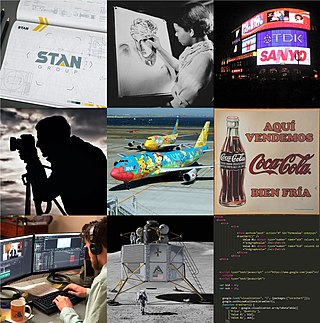
Graphic design is a profession, academic discipline and applied art whose activity consists in projecting visual communications intended to transmit specific messages to social groups, with specific objectives. Graphic design is an interdisciplinary branch of design and of the fine arts. Its practice involves creativity, innovation and lateral thinking using manual or digital tools, where it is usual to use text and graphics to communicate visually.

A storyboard is a graphic organizer that consists of illustrations or images displayed in sequence for the purpose of pre-visualizing a motion picture, animation, motion graphic or interactive media sequence. The storyboarding process, in the form it is known today, was developed at Walt Disney Productions during the early 1930s, after several years of similar processes being in use at Walt Disney and other animation studios.

Commercial art is the art of creative services, referring to art created for commercial purposes, primarily advertising. Commercial art uses a variety of platforms for viewers with the intent of promoting the sale and interest of products, services, and ideas. It relies on the iconic image to enhance recall and favorable recognition for a product or service. An example of a product could be a magazine ad promoting a new soda through complementary colors, a catchy message, and appealing illustrative features. Another example could be promoting the prevention of global warming by encouraging people to walk or ride a bike instead of driving in an eye catching poster. It communicates something specific to an audience.
A title sequence is the method by which films or television programmes present their title and key production and cast members, utilizing conceptual visuals and sound. It typically includes the text of the opening credits, and helps establish the setting and tone of the program. It may consist of live action, animation, music, still images, and/or graphics. In some films, the title sequence is preceded by a cold open.
Art director is the title for a variety of similar job functions in theater, advertising, marketing, publishing, fashion, film and television, the Internet, and video games.

A category of fine art, graphic art covers a broad range of visual artistic expression, typically two-dimensional, i.e. produced on a flat surface. The term usually refers to the arts that rely more on line, color or tone, especially drawing and the various forms of engraving; it is sometimes understood to refer specifically to printmaking processes, such as line engraving, aquatint, drypoint, etching, mezzotint, monotype, lithography, and screen printing. Graphic art mostly includes calligraphy, photography, painting, typography, computer graphics, and bindery. It also encompasses drawn plans and layouts for interior and architectural designs.

A digital on-screen graphic, digitally originated graphic is a watermark-like station logo that most television broadcasters overlay over a portion of the screen area of their programs to identify the channel. They are thus a form of permanent visual station identification, increasing brand recognition and asserting ownership of the video signal.
Communication design is a mixed discipline between design and information-development concerned with how media communicate with people. A communication design approach is concerned with developing the message and aesthetics in media. It also creates new media channels to ensure the message reaches the target audience. Due to overlapping skills, some designers use graphic design and communication design interchangeably.

A graphic designer is a professional who practices the discipline of graphic design, either within companies or organizations or independently. They are professionals in design and visual communication, with their primary focus on transforming linguistic messages into graphic manifestations, whether tangible or intangible. They are responsible for planning, designing, projecting, and conveying messages or ideas through visual communication. Graphic design is one of the most in-demand professions with significant job opportunities, as it allows leveraging technological advancements and working online from anywhere in the world.

A character generator, often abbreviated as CG, is a device or software that produces static or animated text for keying into a video stream. Modern character generators are computer-based, and they can generate graphics as well as text.
A creative director is a person who makes high-level creative decisions; oversees the creation of creative assets such as advertisements, products, events, or logos ; and directs & translates the creative peoples who produce the end results. Creative director positions are often found within the television production, graphic design, film, music, video game, fashion, advertising, media, or entertainment industries, but may be found in other creative organizations such as web development and software development firms as well.

Motion graphic design, also known as motion design, is a subset of graphic design which combines design with animation and/or filmmaking, video production, and filmic techniques. Examples include kinetic typography and graphics used in film and television opening sequences, and station identification logos of some television channels.
Television crew positions are derived from those of film crew, but with several differences.
Graphic design careers include creative director, art director, art production manager, brand identity developer, illustrator and layout artist.
A score bug is a digital on-screen graphic which is displayed at either the top or lower third bottom of the television screen during a broadcast of a sporting event in order to display the current score and other statistics.

Motion graphics are pieces of animation or digital footage that create the illusion of motion or rotation, and are usually combined with audio for use in multimedia projects. Motion graphics are usually displayed via electronic media technology, but may also be displayed via manual powered technology. The term distinguishes static graphics from those with a transforming appearance over time, without over-specifying the form. While any form of experimental or abstract animation can be called motion graphics, the term typically more explicitly refers to the commercial application of animation and effects to video, film, TV, and interactive applications.
A storyboard artist creates storyboards for advertising agencies and film productions.
A graphics coordinator (GC) or font assist is an individual who works, usually on a television show, as a producer of on-air still and motion graphics. The graphics coordinator decides what content should be displayed on-air — such as on a fullpage or a lower third. The GC should not be confused with the Operator, who usually operates a character generator (CG) and is part of a television crew, or a broadcast designer who physically creates the graphics.

George Lois was an American art director, designer, and author. Lois was perhaps best known for over 92 covers he designed for Esquire magazine from 1962 to 1973.

R/GA is an innovation consultancy, and digital design and advertising agency, headquartered in New York City, with global offices in Austin, Los Angeles, San Francisco, Portland, London, Berlin, São Paulo, Buenos Aires, Singapore, Shanghai, Sydney and Tokyo. The company has received a number of industry honors for its creative and media work, including Adweek's Digital Agency of the Decade in 2009 and Campaign Magazine's Digital Innovation Agency of the Decade in 2019. R/GA is a subsidiary of Interpublic Group of Companies.










